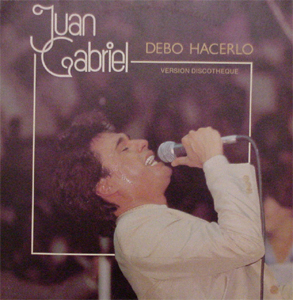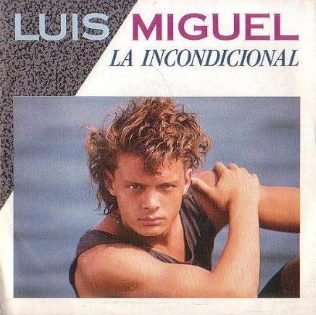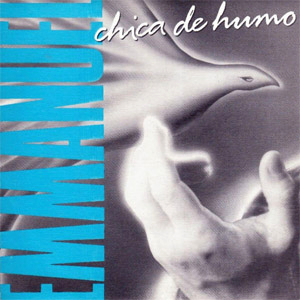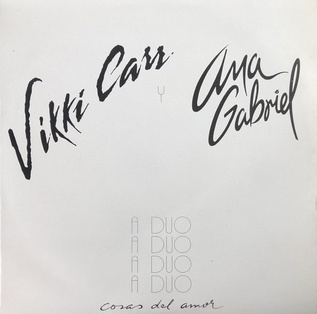Related Research Articles

Héctor Eduardo Reglero Montaner, better known as Ricardo Montaner, is an Argentine-born Venezuelan singer and songwriter. Since starting his career in the late 1970s, he has released more than 24 albums, and many successful singles. He has sold an estimated 100 million records worldwide, making him one of the best-selling Latin music artists.

Franco Atilio De Vita De Vito is a Venezuelan Latin Grammy award-winning singer-songwriter. His first album as a solo artist garnered three Spanish-language hits in Venezuela. He signed with the CBS Records label in 1989, and in 1990, his album Extranjero had a song that reached No. 1 on the United States Latin charts and won an MTV Video Music Award. His 2004 album Stop reached the Top 10 throughout Latin America and on the United States Latin charts. In the United States alone, he has scored more than two dozen hits on the Billboard charts.

"Aquí Estoy Yo" is a song written by Luis Fonsi, Claudia Brant and Gen Rubin; it was produced by Luis Fonsi and Sebastián Krys for Fonsi's seventh studio album Palabras del Silencio (2008), and it is performed by Luis Fonsi, Aleks Syntek, David Bisbal, and Noel Schajris.
"Que No Se Rompa la Noche" literally "May the Night not Break", is a ballad written and produced by Spanish singer-songwriter Manuel Alejandro, co-written by Ana Magdalena, and performed by Spanish singer Julio Iglesias. It was released as the second single from his studio album Un hombre solo (1987). This song became his second number one hit in the Billboard Hot Latin Tracks chart, after his previous single "Lo Mejor de Tu Vida".

"Soy Así" is a ballad written and produced by Spanish composer Rafael Pérez-Botija and performed by Mexican singer José José. It was released as the first single from his twenty fourth studio album of the same title (1987). This song became the second number-one single by the artist in the Billboard Hot Latin Tracks chart, after the single "¿Y Quién Puede Ser?" two years before. In 2005, Mexican late "singer" Valentín Elizalde recorded a cover version of the single and included it on his album of the same name.
"Simplemente Amigos" is a ballad written and performed by Mexican singer-songwriter Ana Gabriel and was produced by Mariano Pérez Bautista. It was released by CBS Discos on March 20, 1989, as the second single from her fourth studio album Tierra de Nadie (1988). The song became Gabriel's second number-one single in the Billboard Hot Latin Tracks chart after "Ay Amor" in late 1987. The success of the song led its parent album to its peak at number one in the Billboard Latin Pop Albums and approximate sales of six million units in Latin America.

"Debo Hacerlo" is a dance song written, produced and performed by Mexican singer-songwriter Juan Gabriel. It was released as the first single from his compilation album of the same title (1987). This song became the last original song recorded by Gabriel, until 1994, due to a copyright dispute with BMG over his repertoire, and was later covered by Ana Gabriel, Nydia Rojas, Pandora, José Octavio and Aleks Syntek.
"Hombres al Borde de un Ataque de Celos" is a dance song written by J.R. Florez, produced by Gian Pietro Felisatti and Loris Ceroni, and performed by Mexican singer Yuri. It was released in 1988 as the first single from her studio album Isla del Sol (1988), and became her second number-one single in the Billboard Hot Latin Tracks chart after "Qué Te Pasa" in 1988. Isla del Sol was the first album recorded by the singer on CBS, her record label until 1995. This song became one of her staple on every live performance and was also included on the live album Vive la Historia.

"La Incondicional" is a pop song written, produced, and arranged by Spanish Juan Carlos Calderón and performed by Mexican singer Luis Miguel. It was released in 1989 as the third single from his studio album entitled Busca una Mujer (1988) and became his second #1 single on the Billboard Hot Latin Tracks chart after "Ahora Te Puedes Marchar" in 1987. The song broke several airplay records in Latin America, topping the charts in Mexico, Chile and Peru; and the top-ten in other countries. The success of the song helped push the album to #3 on the Billboard Latin Pop Albums with approximate sales of four million units.

"Baila Mi Rumba" is a dance song written by Isidore York, Rudy Pérez and V. M. Hernández, produced by Pérez and Emilio Estefan, Jr., and performed by Venezuelan singer José Luis Rodríguez "El Puma". It was released in 1989 as the lead single from his studio album Tengo Derecho a Ser Feliz (1989), and became his second number-one single in the Billboard Hot Latin Tracks chart after "Y Tú También Llorarás" in 1987. The success of the song led its parent album to its peak at number two in the Billboard Latin Pop Albums.

"Fría Como el Viento" is a ballad written, produced and arranged by Juan Carlos Calderón and performed by Mexican singer Luis Miguel. It was released as the first single from the Grammy-nominated studio album Busca una Mujer (1988). The song became the third number-one single for the singer in the Billboard Hot Latin Tracks chart after "Ahora Te Puedes Marchar" in 1987 and "La Incondicional", the preceding single.
"Cómo Fui a Enamorarme de Ti" is a song written and produced Mexican singer-songwriter Marco Antonio Solís, and performed by him as the lead singer of Los Bukis. It was released as the second single from his 12rd studio album Y Para Siempre (1989). This song became their second number-one single in the Billboard Top Latin Songs chart, after "Y Ahora Te Vas" one year prior.

"La chica de humo" is a song by Mexican singer Emmanuel. It was written by Mauro Malavasi and María Lar, and produced by Mauro Malavasi and K. C. Porter for Emmanuel's eleventh studio album Quisiera in February 1989. Released as the second single from the album, the song became the third number-one single for the singer in the Billboard Top Latin Songs chart in late December of the same year. During live performances of the song, parts of "Gonna Make You Sweat " by C+C Music Factory are integrated during the second bridge. This version can be found on the live album Retro En Vivo. It also has been also included on some compilation albums released by Emmanuel, including Personalidad (1992), Grandes Exitos (1996) and Mi Historia Musical (2005) Due to the success of the song, the album Quisiera peaked at number 9 in the Billboard Latin Pop Albums chart in 1990. It is recognized as one of Emmanuel's signature songs.
"Quién Como Tú" is a ballad and title track written and performed by Mexican singer-songwriter Ana Gabriel. It was produced by Óscar Gómez for Gabriel's fifth studio album Quién como tú (1989). Released as the second single from the album, the song became the third number-one single for the singer in the Billboard Top Latin Songs chart in May of the same year. Live performances of the song can be found on the albums En Vivo (1990) and ...En la Plaza de Toros México (1998).
"El Cariño Es Como Una Flor" is a song written, produced and performed by Italo-Venezuelan singer-songwriter Rudy La Scala. It was released as the lead single from Scala's fourth studio album Cuando Yo Amo (1990), and became his first number-one single in the Billboard Top Latin Songs chart while the aforementioned album peaked at number four in the Latin Pop Albums chart. The song became one of his better-known compositions after the success of the theme song from the soap opera Cristal, "Mi Vida Eres Tú", which broke sales records.

Guatemalan recording artist Ricardo Arjona has released 15 studio albums, sixteen compilation albums, two live albums, forty-five singles and two promotional singles. Four of his albums have reached the number-one position on the Billboard Top Latin Albums chart, while four of his singles have topped the Billboard Latin Songs chart. Throughout his career, Arjona has sold approximately 20 million albums worldwide, making him one of the most successful Latin artists in music history. Arjona released his debut album, Déjame Decir Que Te Amo, in 1985. However, his experiences while recording the album and its commercial failure led to his decision to abandon the music industry. Despite this decision, Arjona returned and released Jesús, Verbo No Sustantivo in 1988. In 1991, Arjona signed a record deal with Sony Music and released his third studio album, Del Otro Lado del Sol.

"Cosas del Amor" is a song by American recording artist Vikki Carr and Mexican singer-songwriter Ana Gabriel. It was released as the lead single from Carr's studio album Cosas del Amor (1991). Written by Roberto Livi and Rudy Pérez, the song portrays the relationship between two friends and confidences between both due to marital problems of one of them.
"Amor Mío, ¿Qué Me Has Hecho?" is a song performed by Spanish singer-songwriter Camilo Sesto. It was released as the lead single from his 19th studio album A Voluntad del Cielo (1991). The song was written and produced by Camilo Blanes with additional production by Augusto César and became Sesto's first number-one hit in the Billboard Hot Latin Tracks chart.

"Hoy Tengo Ganas de Ti" is a song written and performed by Spanish singer-songwriter Miguel Gallardo. It was released in 1976 as the lead single from his debut studio album Autorretrato. The song is about a man who tells of his yearnings to a woman who has left. Upon its release, the song was well received in Mexico where it became one of the best-performing songs of the year. Since then, the song has been covered by several artists including Azúcar Moreno, Ricardo Montaner, David Bustamante and Alejandro Fernández.
References
- ↑ "Con la London Metropolitan Orchestra — Ricardo Montaner". Allmusic. Macromedia Corporation. Retrieved 23 December 2009.
- ↑ "Para Meus Amigos — Ricardo Montaner". Allmusic. Macromedia Corporation. Retrieved 23 December 2009.
- 1 2 3 Birchmeier, Jason. "Ricardo Montaner — Biography". Allmusic. Macromedia Corporation. Retrieved 23 December 2009.
- 1 2 3 "Ricardo Montaner — Charts and awards". Allmusic. Macromedia Corporation. Retrieved 23 December 2009.
- ↑ "La Cima del Cielo — Week of December 16, 1989". Billboard. Nielsen Business Media, Inc. 1 December 1989. Retrieved 23 December 2009.
- ↑ "La Cima del Cielo — Week of January 27, 1990". Billboard. Nielsen Business Media, Inc. 2 January 1990. Retrieved 23 December 2009.
- ↑ "La Cima del Cielo — Week of February 10, 1990". Billboard. Nielsen Business Media, Inc. 1 February 1990. Retrieved 23 December 2009.